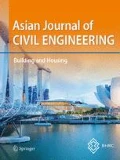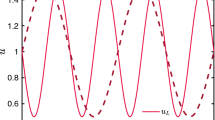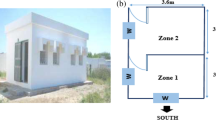Abstract
To improve the calculation accuracy of optimum insulation thickness of building walls, the effects of the initial conditions and the choice of the representative day used as boundary conditions on results have been studied. In this context, the unsteady heat transfer across the multilayer wall was considered as one-dimensional and the problem was solved numerically by an implicit finite difference method. A computational FORTRAN code has been developed and validated to calculate, under real meteorological data (RMD), the cooling transmission loads and the optimum insulation thickness during the summer period in the Sahara of Algeria. For steady periodic conditions, the influence of the initial conditions on the precision of the numerical result has been studied for two cases of representative days (July 15 and 21). By comparing the results with the case of real conditions (RMD), we find that the choice of July 15 as a typical day gives more accurate results than the choice of July 21. In addition, the difference of cooling transmission loads of 76.2% for July 15 and 76.31% for July 21 is observed, between the use of a repeated and another non-repeated typical day.












Similar content being viewed by others
Abbreviations
- \(a\) :
-
Thermal diffusivity (m2/s)
- \(A_{\text{Es}}\) :
-
Annual cost of energy saved ($/m2 year)
- \(C\) :
-
Specific heat (J/kg K)
- \(C_{\text{c}}\) :
-
Yearly cost of energy consumed by air-conditioning ($/m2 year)
- \(C_{\text{e}}\) :
-
Cost of electricity ($/kWh)
- \(C_{\text{i}}\) :
-
Cost of insulation material ($/m3)
- COP:
-
Coefficient of performance of the air-conditioning system
- \(C_{\text{t}}\) :
-
Total cost ($/m2)
- d :
-
Inflation rate (%)
- \(h_{\text{o}}\) :
-
Heat transfer coefficient at the outdoor of multilayer wall surface (W/m2 K)
- \(h_{\text{i}}\) :
-
Heat transfer coefficient at the indoor of multilayer wall surface (W/m2 K)
- i :
-
Interest rate (%)
- \(I_{\text{T}} \left( t \right)\) :
-
Total solar radiation (W/m2)
- \(k\) :
-
Thermal conductivity (W/mK)
- \(L_{\text{i}}\) :
-
Insulation thickness (m)
- \(L_{\text{opt}}\) :
-
Optimum insulation thickness (m)
- \({\text{MBE}}\) :
-
Mean bias error
- n :
-
Lifetime period (years)
- \({\text{PWF}}\) :
-
Worth factor
- \(P_{\text{b}}\) :
-
Payback period (years)
- \(q_{\text{o}}\) :
-
Heat flux at outdoor surface of the multilayer wall (W/m2)
- \(q_{\text{i}}\) :
-
Heat flux at indoor surface of the multilayer wall (W/m2)
- \(Q_{\text{c}}\) :
-
Cooling transmission load for insulated wall (MJ/m2 years)
- \({Q_{\text{c-unins}}}\) :
-
Cooling transmission load for uninsulated wall (MJ/m2 years)
- \(Q_{\text{h}}\) :
-
Heat delivered at the hot reservoir (external environment)
- RMD:
-
Reel meteorological data
- \({\text{RMSE}}\) :
-
Root mean square error
- \(t\) :
-
Time (s)
- \(T_{\text{Es}}\) :
-
Total cost saved during the lifetime of building ($/m2)
- \(T_{\text{e}} \left( t \right)\) :
-
Sol–air temperature (K)
- \(T_{\text{in}}\) :
-
Indoor air temperature (K)
- \(T_{\text{o}} \left( t \right)\) :
-
Outdoor air temperature as a function of time (K)
- \(T_{\text{wi}}\) :
-
Indoor wall surface temperature (K)
- \(T_{\text{wo}}\) :
-
Outdoor wall surface temperature (K)
- \(W\) :
-
Compressors dissipated work (MJ/m2 years)
- \(x_{i}\) :
-
Indoor wall surface temperature obtained from Fluent or CodyMur (K)
- \(y_{\text{i}}\) :
-
Indoor wall surface temperature obtained from the FORTRAN code (K)
- ρ :
-
Density (kg/m3)
- α :
-
Solar absorptivity (equal to 0.8)
- \(\Delta x\) :
-
Space step (m)
- \(\Delta t\) :
-
Time step (s)
References
Al-Sanea, S., & Zedan, M. (2002). Optimum insulation thickness for building walls in a hot-dry climate. International Journal of Ambient Energy,23(3), 115–126.
Al-Sanea, S. A., & Zedan, M. (2012). Effect of thermal bridges on transmission loads and thermal resistance of building walls under dynamic conditions. Applied Energy,98, 584–593.
Al-Sanea, S. A., Zedan, M., & Al-Ajlan, S. A. (2005). Effect of electricity tariff on the optimum insulation-thickness in building walls as determined by a dynamic heat-transfer model. Applied Energy,82(4), 313–330.
Al-Sanea, S. A., Zedan, M., Al-Mujahid, A., & Al-Suhaibani, Z. (2016). Optimum R-values of building walls under different climatic conditions in the Kingdom of Saudi Arabia. Applied Thermal Engineering,96, 92–106.
Alsayed, M. F., & Tayeh, R. A. (2019). Life cycle cost analysis for determining optimal insulation thickness in Palestinian buildings. Journal of Building Engineering,22, 101–112.
Bolattürk, A. (2008). Optimum insulation thicknesses for building walls with respect to cooling and heating degree-hours in the warmest zone of Turkey. Building and Environment,43(6), 1055–1064.
Daouas, N. (2011). A study on optimum insulation thickness in walls and energy savings in Tunisian buildings based on analytical calculation of cooling and heating transmission loads. Applied Energy,88(1), 156–164.
Daouas, N. (2016). Impact of external longwave radiation on optimum insulation thickness in Tunisian building roofs based on a dynamic analytical model. Applied Energy,177, 136–148.
Daouas, N., Hassen, Z., & Aissia, H. B. (2010). Analytical periodic solution for the study of thermal performance and optimum insulation thickness of building walls in Tunisia. Applied Thermal Engineering,30(4), 319–326.
Derradji, L., Imessad, K., Amara, M., & Errebai, F. B. (2017). A study on residential energy requirement and the effect of the glazing on the optimum insulation thickness. Applied Thermal Engineering,112, 975–985.
Dlimi, M., Iken, O., Agounoun, R., Kadiri, I., & Sbai, K. (2019). Dynamic assessment of the thermal performance of hemp wool insulated external building walls according to the Moroccan climatic zoning. Journal of Energy Storage,26, 101007.
Ekici, B. B., Gulten, A. A., & Aksoy, U. T. (2012). A study on the optimum insulation thicknesses of various types of external walls with respect to different materials, fuels and climate zones in Turkey. Applied Energy,92, 211–217.
Gasparin, S., Berger, J., Dutykh, D., & Mendes, N. (2019). An innovative method to determine optimum insulation thickness based on non-uniform adaptive moving grid. Journal of the Brazilian Society of Mechanical Sciences and Engineering,41(4), 173.
Ghrab-Morcos, N. (1991). Energy and financial considerations related to wall design for a conditioned cell in Tunisian conditions. Renewable Energy,1(1), 145–159.
Handbook, A. F. (2009). American society of heating, refrigerating and air-conditioning engineers. Atlanta, GA: Inc.
Hasan, A. (1999). Optimizing insulation thickness for buildings using life cycle cost. Applied Energy,63(2), 115–124.
Kaşka, Ö., & Yumrutaş, R. (2008). Comparison of experimental and theoretical results for the transient heat flow through multilayer walls and flat roofs. Energy,33(12), 1816–1823.
Kaşka, Ö., Yumrutaş, R., & Arpa, O. (2009). Theoretical and experimental investigation of total equivalent temperature difference (TETD) values for building walls and flat roofs in Turkey. Applied Energy,86(5), 737–747.
Kayfeci, M., Keçebaş, A., & Gedik, E. (2013). Determination of optimum insulation thickness of external walls with two different methods in cooling applications. Applied Thermal Engineering,50(1), 217–224.
Kuin, T., Ramsey, W., & Threlkeld, J. (1998). Thermal environment engineering. Englewood Cliffs, NJ: Prentice-Hall.
Kuznik, F., Virgone, J., & Noel, J. (2008). Optimization of a phase change material wallboard for building use. Applied Thermal Engineering,28(11), 1291–1298.
Meteonorm. (2014). Handbook. Part I: Software, Version 7.1 September 2014.
Mirrahimi, S., Mohamed, M. F., Haw, L. C., Ibrahim, N. L. N., Yusoff, W. F. M., & Aflaki, A. (2016). The effect of building envelope on the thermal comfort and energy saving for high-rise buildings in hot–humid climate. Renewable and Sustainable Energy Reviews,53, 1508–1519.
Ozel, M. (2013a). Determination of optimum insulation thickness based on cooling transmission load for building walls in a hot climate. Energy Conversion and Management,66, 106–114.
Ozel, M. (2013b). Thermal, economical and environmental analysis of insulated building walls in a cold climate. Energy Conversion and Management,76, 674–684.
Ozel, M. (2019). Influence of glazing area on optimum thickness of insulation for different wall orientations. Applied Thermal Engineering,147, 770–780.
Ozel, M., & Pihtili, K. (2007). “Optimum location and distribution of insulation layers on building walls with various orientations. Building and Environment,42(8), 3051–3059.
Ozkahraman, H. T., & Bolatturk, A. (2006). The use of tuff stone cladding in buildings for energy conservation. Construction and Building Materials,20(7), 435–440.
Pekdogan, T., & Basaran, T. (2017). Thermal performance of different exterior wall structures based on wall orientation. Applied Thermal Engineering,112, 15–24.
Ramin, H., Hanafizadeh, P., & Akhavan-Behabadi, M. A. (2016). Determination of optimum insulation thickness in different wall orientations and locations in Iran. Advances in Building Energy Research,10(2), 149–171.
Sonelgaz. (2019). 14 343 MW: Nouveau Record Historique de Consommation Electrique. https://www.sonelgaz.dz/2307/14-343-mw-nouveau-record-historique-de-consommation-electrique-4. Accessed 10 Feb 2020.
Toguyeni, D. Y., Coulibaly, O., Ouedraogo, A., Koulidiati, J., Dutil, Y., & Rousse, D. (2012). Study of the influence of roof insulation involving local materials on cooling loads of houses built of clay and straw. Energy and Buildings,50, 74–80.
Vincelas, F. F. C., Ghislain, T., & Robert, T. (2017). Influence of the types of fuel and building material on energy savings into building in tropical region of Cameroon. Applied Thermal Engineering,122, 806–819.
Virgone, J., & Noel, J. (2003). ARCHICUBE et CODYMUR, logiciels de simulation des ponts thermiques et du comportement thermique d’une paroi en régime variable. In VIe Colloque InterUniversitaire Franco-Québécois.
Wati, E., Meukam, P., & Nematchoua, M. K. (2015). Influence of external shading on optimum insulation thickness of building walls in a tropical region. Applied Thermal Engineering,90, 754–762.
World Map of Koppen-Geiger. (2006). World Map of Koppen-Geiger Climate classification. Available: http://koeppen-geiger.vu-wien.ac.at/pics/kottek_et_al_2006.gif. Accessed 10 Feb 2020.
Yu, J., Tian, L., Yang, C., Xu, X., & Wang, J. (2011). Optimum insulation thickness of residential roof with respect to solar-air degree-hours in hot summer and cold winter zone of china. Energy and Buildings,43(9), 2304–2313.
Yu, J., Yang, C., Tian, L., & Liao, D. (2009). “A study on optimum insulation thicknesses of external walls in hot summer and cold winter zone of China. Applied Energy,86(11), 2520–2529.
Yumrutaş, R., Ünsal, M., & Kanoğlu, M. (2005). Periodic solution of transient heat flow through multilayer walls and flat roofs by complex finite Fourier transform technique. Building and Environment,40(8), 1117–1125.
Funding
This research did not receive any specific grant from funding agencies in the public, commercial or not-for-profit sectors.
Author information
Authors and Affiliations
Corresponding author
Ethics declarations
Conflict of interest
On behalf of all authors, the corresponding author states that there is no conflict of interest.
Additional information
Publisher's Note
Springer Nature remains neutral with regard to jurisdictional claims in published maps and institutional affiliations.
Rights and permissions
About this article
Cite this article
Necib, H., Necib, B. Improve the calculation accuracy of the optimal insulation thickness in building walls as determined by a dynamic heat transfer model. Asian J Civ Eng 21, 903–913 (2020). https://doi.org/10.1007/s42107-020-00248-w
Received:
Accepted:
Published:
Issue Date:
DOI: https://doi.org/10.1007/s42107-020-00248-w




